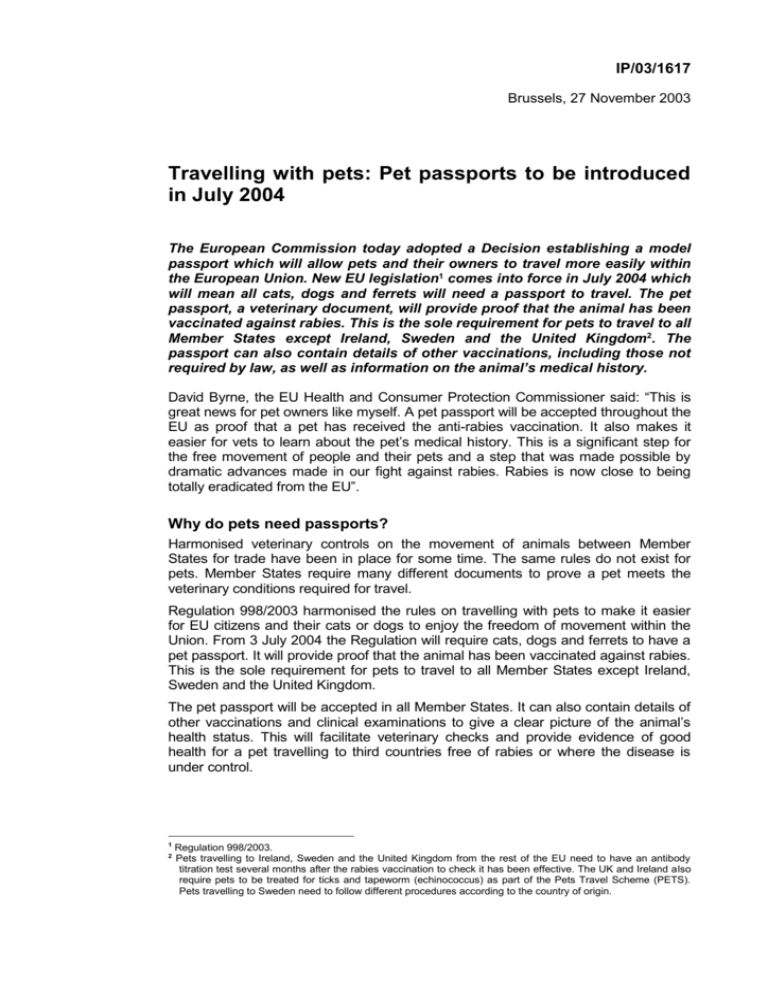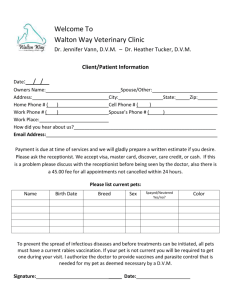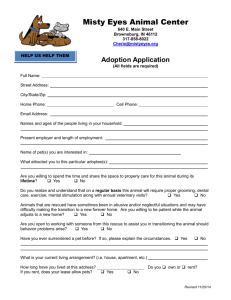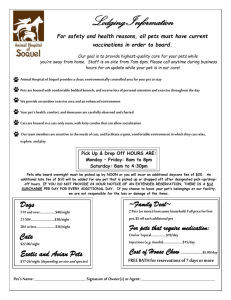DOC - Europa
advertisement

IP/03/1617 Brussels, 27 November 2003 Travelling with pets: Pet passports to be introduced in July 2004 The European Commission today adopted a Decision establishing a model passport which will allow pets and their owners to travel more easily within the European Union. New EU legislation1 comes into force in July 2004 which will mean all cats, dogs and ferrets will need a passport to travel. The pet passport, a veterinary document, will provide proof that the animal has been vaccinated against rabies. This is the sole requirement for pets to travel to all Member States except Ireland, Sweden and the United Kingdom2. The passport can also contain details of other vaccinations, including those not required by law, as well as information on the animal’s medical history. David Byrne, the EU Health and Consumer Protection Commissioner said: “This is great news for pet owners like myself. A pet passport will be accepted throughout the EU as proof that a pet has received the anti-rabies vaccination. It also makes it easier for vets to learn about the pet’s medical history. This is a significant step for the free movement of people and their pets and a step that was made possible by dramatic advances made in our fight against rabies. Rabies is now close to being totally eradicated from the EU”. Why do pets need passports? Harmonised veterinary controls on the movement of animals between Member States for trade have been in place for some time. The same rules do not exist for pets. Member States require many different documents to prove a pet meets the veterinary conditions required for travel. Regulation 998/2003 harmonised the rules on travelling with pets to make it easier for EU citizens and their cats or dogs to enjoy the freedom of movement within the Union. From 3 July 2004 the Regulation will require cats, dogs and ferrets to have a pet passport. It will provide proof that the animal has been vaccinated against rabies. This is the sole requirement for pets to travel to all Member States except Ireland, Sweden and the United Kingdom. The pet passport will be accepted in all Member States. It can also contain details of other vaccinations and clinical examinations to give a clear picture of the animal’s health status. This will facilitate veterinary checks and provide evidence of good health for a pet travelling to third countries free of rabies or where the disease is under control. 1 2 Regulation 998/2003. Pets travelling to Ireland, Sweden and the United Kingdom from the rest of the EU need to have an antibody titration test several months after the rabies vaccination to check it has been effective. The UK and Ireland also require pets to be treated for ticks and tapeworm (echinococcus) as part of the Pets Travel Scheme (PETS). Pets travelling to Sweden need to follow different procedures according to the country of origin. What will the passport look like? The pet passport will measure 100 x 152 mm with a blue cover and the yellow stars of the European emblem. The languages used will be English and the official language of the Member State where the passport is issued. The words “European Union” and the name of the Member State will appear on the cover, along with the passport number which is the ISO code of the Member State followed by a unique number. What difference will it make? Travelling with pets will become much easier. All the different documents needed for travel into each Member State will be replaced by one veterinary document, the pet passport, which will be recognised across the EU. Visits to the vet will also become much more straightforward as the passport can instantly inform the vet about the pet’s medical history. More information: IP/02/950. If you would like to receive a copy of the passport electronically, please send an e-mail to ilse.gordts@cec.eu.int, indicating the language. 2





